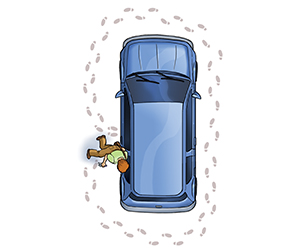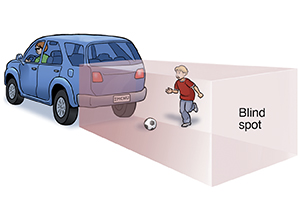Keeping Children Safe in and Around Cars
Cars present many dangers to children. To help keep your child safe, learn what these dangers are and follow simple safety precautions. Three important things you can do are:
-
Never leave your child alone in a car—ever.
-
Teach your child that a car is not a toy. Don’t allow kids to play in the car.
-
Always walk all the way around your car before getting in. This lets you make sure no children are playing behind the car or in front of it.
-
Always look up and down sidewalks before backing out of a driveway.
 |
| Before you start your car, walk around the whole car to make sure no children are near it. |
Read on for more details about keeping your child safe in and around cars.
Safety inside the car
Leaving a child alone in a car is very dangerous. Following are the main safety hazards for children left in cars and how to prevent them.
Heat
The temperature inside a car can rise much more quickly than the outdoor temperature. This is true in a closed car, or even one with an open window. Research shows a car’s interior temperature can rise nearly 20 degrees in 10 minutes. Also, a child’s temperature rises faster than an adult’s. A child can suffer permanent brain or organ damage or die within minutes of being left in a hot car.
Strangulation
A child can lean on an automatic window switch and close the window. This can catch their head and neck in the window and strangle the child.
Other dangers
If keys are left in the car, the child can start the engine. The car might run over people or crash. Even without keys, the child might shift gears or release the emergency brake, causing the car to roll.
Carbon monoxide poisoning
Carbon monoxide is an odorless gas emitted from idling car engines that could easily sicken children or even cause death.
Keeping your child safe from car hazards
-
Never leave your child alone in a car, even for a minute.
-
Never leave the engine on with your car idling in the garage, even when your intent is to run into the house for just 1 minute. Always turn the engine off when exiting the car.
-
Always lock your car when you leave it, even in the garage, and keep your keys and remote entry devices out of reach. This prevents children from getting inside.
-
Teach your child that the car is not a toy. It is only for riding in with an adult.
-
Give yourself reminders that a child is in the back seat. For instance,
-
Tie something on the steering wheel, put the diaper bag or a favorite toy in the front seat, or put your cell phone, briefcase, or purse in the back seat.
-
Put your child's car seat in the middle of the back seat. This makes it easier to see your baby in the rearview mirror.
-
Pay particular attention if your routine changes. Set up a "safety system" with your child-care provider. For example, call them if you're not going to drop off your child, but if you don't call, have them call you when your child doesn't arrive at the expected time.
-
Talk to anyone who drives your child anywhere—partners, grandparents, babysitters, and friends—and explain hot car deaths.
-
ALWAYS "look before you lock" and check the back seat every time you get out of the car.
-
Use drive-through services whenever possible, such as at banks and pharmacies. That way, you don’t have to get out of the car.
-
If you see a child unresponsive in a car, call 911, get the child out of the car, and spray the child with cool water. If the child is responsive, call 911, stay with the child until help arrives, and have someone else search for the driver. Don’t worry about getting involved; protecting the child is the priority. “Good Samaritan” laws offer legal protection for those who offer assistance in an emergency.
Trunk safety
It’s easy for a child to get locked in a car trunk. An unlocked car and a curious child are all it takes. Rising temperature and a lack of air in the trunk can quickly kill your child. To avoid this tragedy, do the following:
-
Remind your child that the car is not a place to play.
-
Make sure your car has a release latch inside the trunk. Many newer cars have them. If your car does not, have the car retrofitted with a glow-in-the-dark trunk release. In either case, teach your child how to use the release.
-
If a child is missing, check the trunk right away. Every second counts.
-
Never put your child in a car trunk—ever, for any reason.
Safety around the car
 |
| It can be difficult to spot children behind your car in your blind spot. It is especially hard when driving a larger vehicle such as a minivan or SUV (sport utility vehicle). |
Children behind a car can be hard to see from the driver’s seat. They can easily be hidden in the blind spot (the area behind the car not visible to the driver, even with mirrors). This can lead to a child being run over.
Think about getting a backup camera or an alarm that sounds when you back up. These devices are available in some newer cars, and they can be installed in older cars. But no matter what equipment you use, always walk behind your car to check for kids.
Take precautions
-
Take a 5-second walk completely around your car before you get in. This lets you see children playing behind or in front of the car.
-
When backing out of a garage or driveway, know where your children are. Have them stand in a place where you can see them clearly. Or, have another adult tell you where the kids are.
-
Roll down your window so you can hear what’s happening around your car.
-
Back your car out slowly. If you're backing out of a driveway, be certain to check both ways for children on the sidewalks.
Teach your children to be safe
-
Instruct your kids to move away from a vehicle whenever it is started. And teach them how to recognize when a vehicle is on. For instance, tell them to look for things such as brake lights, white lights for backing up, and engine noise.
-
If possible, keep children from playing in the driveway or front yard. Instead, have them play in a fenced-in backyard or park. If a child does play in the front yard, make sure they are supervised by an adult.
-
Hold your child’s hand when walking with your child near cars. Do this in places such as parking lots, driveways, and on sidewalks.
-
When walking with young children on sidewalks, don't let them run ahead of you and cross driveways unsupervised.